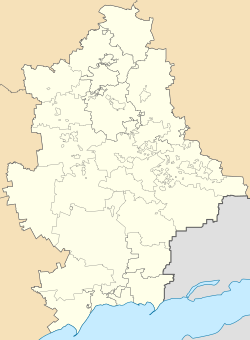Horlivka
|
Horlivka/Gorlovka Горлівка/Горловка |
|||
|---|---|---|---|
| City of regional significance | |||

Horlivka Palace of Culture
|
|||
|
|||
| Location of Horlivka | |||
| Coordinates: 48°18′N 38°3′E / 48.300°N 38.050°ECoordinates: 48°18′N 38°3′E / 48.300°N 38.050°E | |||
|
Country Oblast Raion |
Ukraine Donetsk Oblast Horlivka Municipality |
||
| Government | |||
| • Mayor | Yevhen Klep | ||
| Area | |||
| • Total | 422 km2 (163 sq mi) | ||
| Population (2013) | |||
| • Total | 256,714 | ||
| • Density | 686.9/km2 (1,779/sq mi) | ||
| Climate | Dfb | ||
Horlivka (Ukrainian: Го́рлівка Ukrainian pronunciation: [ˈɦɔrliu̯kɑ]); also known by its Russian name Gorlovka (Russian: Горловка) or Gorlowka, is a city of regional significance in the Donetsk Oblast (province) of eastern Ukraine. In 2001, the city's population was 292,000, which declined to 256,714 by 2013. Economic activity is predominantly coal mining and the chemical industry. The Horlivka State Pedagogical Institute of Foreign Languages has a two building campus in the center of town.
The city was severely damaged during the War in Donbass and has since been mainly under control of pro-Russian forces. Suburbs of Horlivka stayed under Ukrainian army control.
In 1779 the city was founded as Gosudarev Posad and in 1869 it was renamed after Pyotr Gorlov as Gorlovka (locally Horlivka). The workers' town provided basic services to and organization of a series of mining camps.
During the Russian Revolution of 1905, it was the scene of an armed uprising.
Subsequently, under Soviet control, by the 1930s it had expanded considerably and become a major center for mining operations in the Ukrainian SSR.
The city was occupied by German troops from 1941-1943. During World War II retreating Nazis burned buildings and perpetrated mass shootings. Nonetheless, the city's population had risen to over 400,000 by the end of the war.
...
Wikipedia



